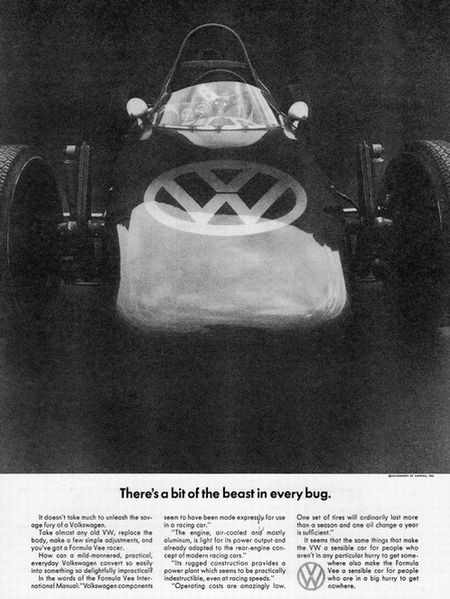フォード・マスタング(Wikipedia)の初代は1964年のニューヨーク万博に発表されたとしている。
この広告の『ニューヨーカー』への掲載は、1967.02.11号。
マスタング(野生馬)とかワイルド・キャット(山猫)などのネーミングに対抗した訴求だったのかもしれないと、いまになっておもいいたっている。
末尾に、「車ジャングルに生きるビートル」といった意味の広告をご参考までに。1967.06.16号『ライフ』誌に掲載と、hiroysato さんが調べてくださいました。ありがとうございます。
かぶと虫だって野獣性を秘めているんですよ。
フォルクスワーゲンの野獣性をよみがえらすのに、そう手間はかかりません。
とんなに古いVWでも、ボディをはずし、ちょっと手を加えれば、ほら、フォーミュラVeeレースカーの出来上がりです。
あのおとなしく、実用的なフォルクスワーゲンが、そんなに簡単にすばらしくて、非実用的なレーシングカーに変わってしまうか---ですって?
フォーミュラVee国際手引書によれば、「フォルクスワーゲンの構造はレーシング・カー用につくられているかのようである」とあります。
「エンジンはアルミ製の空冷式で、軽量にもかかわらず出力が大きく、すでに最近のレーシング・カーの常識となっているリア・エンジン方式をとっている」
「頑丈な構造をしていて、どんな高速レースにも耐えられるパワー装置になっている」
「維持費は驚くほど少なくてすむ。タイヤは1組で1シーズン以上もつし、オイル交換も1年に1回で十分である」
どうやら、どこかへ行きたいが、とくに急ぐ必要のない人びとにぴったりなのがVWなら、別にどこどこへ行くというのではないがとにかく大急ぎで走らねばならない人々にはフォーミュラVeeがぴったり。 その理由は同じようですね。
C/W
"The NEWYORKER", 1967.02.11
A/DThe beetle's ads series with "NEWYORKER's archive" (61)
There's a bit of the beast in every bug.
It doesn't take much to unleash the savage fury of a Volkswagen.
Take almost any old VW, replace the body, make a few simple adjustments, and you've got a Formula Vee racer.
Hcon a mild-mannered, practical, everyday Volkswagen convert so easily into something so delightfully impractical?
In the words of the Formula Vee inlernotional Manual:"Volkswagen components seem to have been made expressly for use in a racing car."
"The engine, air-cooled and mostly aluminum, is light for its power output and already adopted to the rear-engine concept of modern racing cars."
"Its rugged construction provides a power plant which seems to be practically indestructible, even at racing spe.eds."
"Operating costs are amazingly low. One set of tires will ordinarily lost more than a season and one oil change a year is sufficient."
It seems that the some things that make the a sensible car for people who aren't in any particulor hurry to get somewhere also make the Formula Vee a sensible cor for people who are in a big hurry to get nowhere.
C/W
A/D"The NEWYORKER", 1967.02.11
車ジャングルで、小さなカブト虫は
どうやって生きながらえているのでしょう?
目立たないからです。
ガソリン・スタンドにもめったに姿を現わしません。そんなにガソリンを必要としないのです(リッターあたり平均11.5km走ります)。タイヤ交換もあまり必要ありません(1組で約64,000kmもちます)。
それに、水のそばには決して近づきません(フォルクスワーゲンのエンジンは水冷式ではなく空冷式ですから、不凍液も要りません)。
ご存じのように、カブト虫の世話や食費のための出費は、たいしたものではありません。
だから、獰猛なジャングルの動物ではありませんが、家庭用のペットとしては理想的です。
これが1949年に米国へやってきた小さな2匹のカブト虫が200万匹にも増えた理由です。
"LIFE" 19767.06.16
How does a little bug survive
in the automotive iungle?
Inconspicuously.
It's rarely observed around gas stations.
Because it doesn't often need gas. (It gets around 27 miles to a gallon.) It doesn't often need tires. (It gets around 40,(0) miles
to a set.) And it never goes near the water. A( Volkswagen's engine is cooled by air in stead of water, which means it doesn't need
anti-freeze either.)
As you can see, the care and feeding of a bug doesn't amount to much. So even though it isn't one of those real wild jungle
animals, it makes on ideal house pet.
That explains how 2 little bugs who come
to America in 1949 multiplied into 2,000,000.
"LIFE" 1967.06.16
【お遊戯】。以下のジャングルの動物たちの所属会社名は? (お分かりの方は、コメント欄へ)
上中央から時計まわり---
1.フォーク(わし)
2.ファルコン(たか)
3.クーガ(ひょう)
4.ワイルド・キャット(やまねこ)
5.バラクダ(大カマス)
6.スティングレイ(あかえい)
7.マーリン(まかじき)
8.マリブ、インパーラ(かもしか)
9.マスタング(野生馬)
10.タイガー(とら)

